Game "Life": simulate evolution
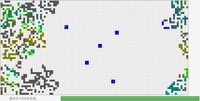 In the comments on my previous post, “The Game of Life and Modeling of Natural Selection,” the first thing they suggested was to add crosses so that the new cell does not receive a copy of the genome of one parent, but a mixture of several. I suspected that the outcome would not change. But, twisting the idea in his head, he became interested: after all, this is how you can get a model not just of natural selection, but of a complete evolution. Fortunately, it was not difficult to implement. So meet: "Life", now with crosses and mutations.
In the comments on my previous post, “The Game of Life and Modeling of Natural Selection,” the first thing they suggested was to add crosses so that the new cell does not receive a copy of the genome of one parent, but a mixture of several. I suspected that the outcome would not change. But, twisting the idea in his head, he became interested: after all, this is how you can get a model not just of natural selection, but of a complete evolution. Fortunately, it was not difficult to implement. So meet: "Life", now with crosses and mutations. Well, yes, also with mutations. To simulate, so to simulate.
Details, as usual, under the cut.
UPD 04/30/2019: I had to remove links to the game from the post: I did not renew the domain where it was located, and it was intercepted
It just so happened that I got "alien" cells, which for birth need not 2, but 3 parents. It would be possible to change the rules of the game, but who am I to argue with Conway? I had to work with what is. As a result, I made it so that the nascent cell receives, as the value of each gene, the value of the corresponding gene of one of its three parents, chosen at random. Plus, I simplified my life somewhat by the fact that genes are taken only from direct parents, i.e. the genes of grandparents in the cell cannot appear. For the first approximation, this is enough.
Since we were talking about changing the genome, it was a sin to get around the topic of mutations. I made sure that with some probability (by default 0.01) one of the genes of the cell mutates - it is set to a random value (0/1).
Well, so that life would not seem like paradise to my wards, I forbade the activation of genes 2 and 3 in the first generation (which, as we recall, are responsible for the maximum adaptability of the cell to the rules of the game). It turned out that the most adapted cells [0,0,1,1,0,0,0,0,0,0] can appear only as a result of mutations, fixed by natural selection.
My expectations were met almost completely.
We will observe the life of the population, which is obtained at the default settings. Please note: in the first generation of active genes 4. I.e. not only are they all “wrong,” they are also interfering with genetic debris when the “right” genes in the cell still appear.
At first, all the cells are red and blue. And they quickly die out.
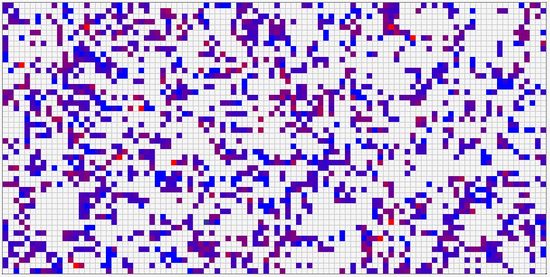
If there are more than 4 active genes, they die out so quickly that the population can completely disappear. But at 4, some foci of life continue to warm long enough so that, thanks to mutations, cells with 1 “correct” gene appear.
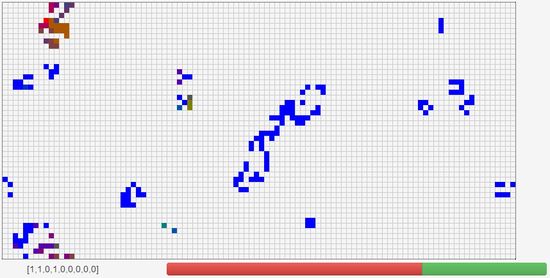
Littering with extra genes, dirty brown, but they still do not die, but multiply, gradually turning green.
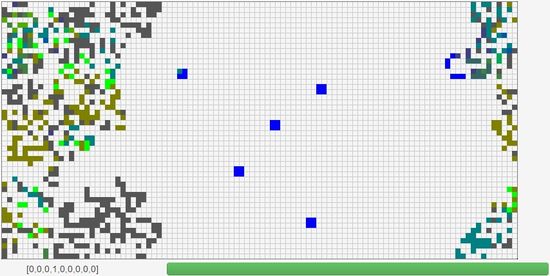
And now we see how the ideal ones appear [0,0,1,1,0,0,0,0,0,0]. They not only acquired 2 necessary genes, but also got rid of the “garbage” that interferes with life.
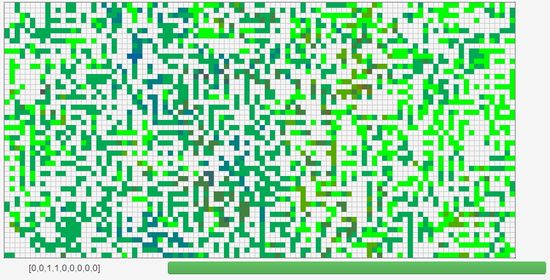
And now they are gradually conquering living space from their less perfect relatives.
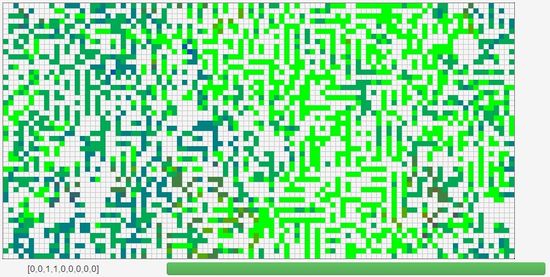
Unfortunately, I could not wait for the moment when they won a complete victory. Most likely, the point here is the limitations of the universe. When the number of cells reaches saturation, the strength of natural selection weakens. The cells are located so close to each other that for reproduction it is no longer necessary to have the most efficient genome: neighbors will be found anyway.
You can continue the action of selection, for example, by occasionally arranging “cataclysms” that kill part of the cells, but I thought that it was already producing some kind of too artificial conditions.
The main thing is that the result has been achieved: in a system that lives by simple laws, we saw the emergence of an initially non-existent "ideal" cell from ancestral cells far from ideal.
Impressive.
